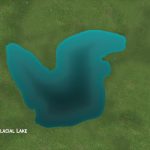Cold Water Muskies
 Mid-October to ice-up. Prime time muskie fishing. This is where I typically use the phrase "troll-o-rama." And why not?
Mid-October to ice-up. Prime time muskie fishing. This is where I typically use the phrase "troll-o-rama." And why not?
On deep, clear lakes, we have a lot of success trolling 10 to 25 feet deep on the edges of the main basin. We focus on what I call pivot points-main lake structural elements such as major points that migrating fish encounter as they move toward their wintering areas. Big hungry muskies get big by tuning into the baitfish migrations, so you’ll find concentrations of muskies on these pivot points. Other key areas are funnels or narrows that, again, concentrate migrating muskie food. Try trolling deeper-running crankbaits, like Depth Raiders, Cisco Kids, 10-inch Believers, and 8-inch Ernies, around the major points, through the narrows and funnels, and along deep weedlines and walls.
Tip: Hang your lake map on a wall and step back ten feet. You can spot the major migration obstacles and funnels better from that distance.
The same patterns apply on shallower, more fertile lakes. The biggest difference is in trolling depth-tight to structure, in the 8-12 foot range is a good rule of thumb where I fish. Try trolling 8-inch Believers, 10-inch Jakes, and jerkbaits, such as Bobbies, Suicks, and Stidham Sensors, along shallow rocky shorelines.
But trolling isn’t the only game in town. Some lakes and some fantastic late fall muskie spots cannot be trolled. Some cannot be trolled because their configuration-tight inside turns, thick matted dead weeds, massive treacherous reefs-is untrollable. And some cannot be trolled because trolling is not allowed, as on most class A Wisconsin muskie waters.
For me, the number one alternative when the muskies are tight to the breaks is slow-rolling spinnerbaits (Rad Dogs are my favorites) down shoreline edges, weedlines, and along the sides of saddles, points, and humps.
When the muskies are up on the flats on sun-warmed late fall afternoons, working Sensors, Suicks, Reef Hawgs, Burts, and 10-inch Believers on the shallow connection is a great tactic. In these situations, working large-bladed and double-bladed bucktails, such as Eagle Tails, Shumway’s Flashers, and tandem spinnerbaits, such as Rad Dogs, Shumway’s Funky Chicken spinnerbait, can be equally effective. Use large, high-lift blades to allow you to work them slowly. A third alternative, believe it or not, is to throw topwaters over these flats. Some of my guide friends in northern Minnesota throw topwaters until ice-up. One year, in 49 degree water, one of them caught eight muskies over 42 inches, all on topwaters.
Working swimming head jigs and plastics such as lizards, Mogambo Grubs, Kalin Grubs, shad bodies, Slug-Gos, and creatures is a great way to catch cold, sluggish fish.
Finally-at the very bitter end of the season, try working a Sonar-like muskie bait, called the "Fuzzy Duzzit," vertically for very deep, cold, sluggish muskies. Some folks do this throughout the fall, but for me, this is an end-of the-season tactic. Plastics on heavy jigheads, and even spoons can also be jigged vertically, but they don’t give you the vibrating "feel" and strike-triggering attraction that the Fuzzy Duzzit gives.
When the water temperature falls through the 50s and 40s, and right up to ice-up, trolling is great, but there are several other ways to catch your fish of the year. If you’d rather sit in a deer stand, you have my blessing. I’m greedy.
Catch a nice one and let it go. Let them ALL go.





